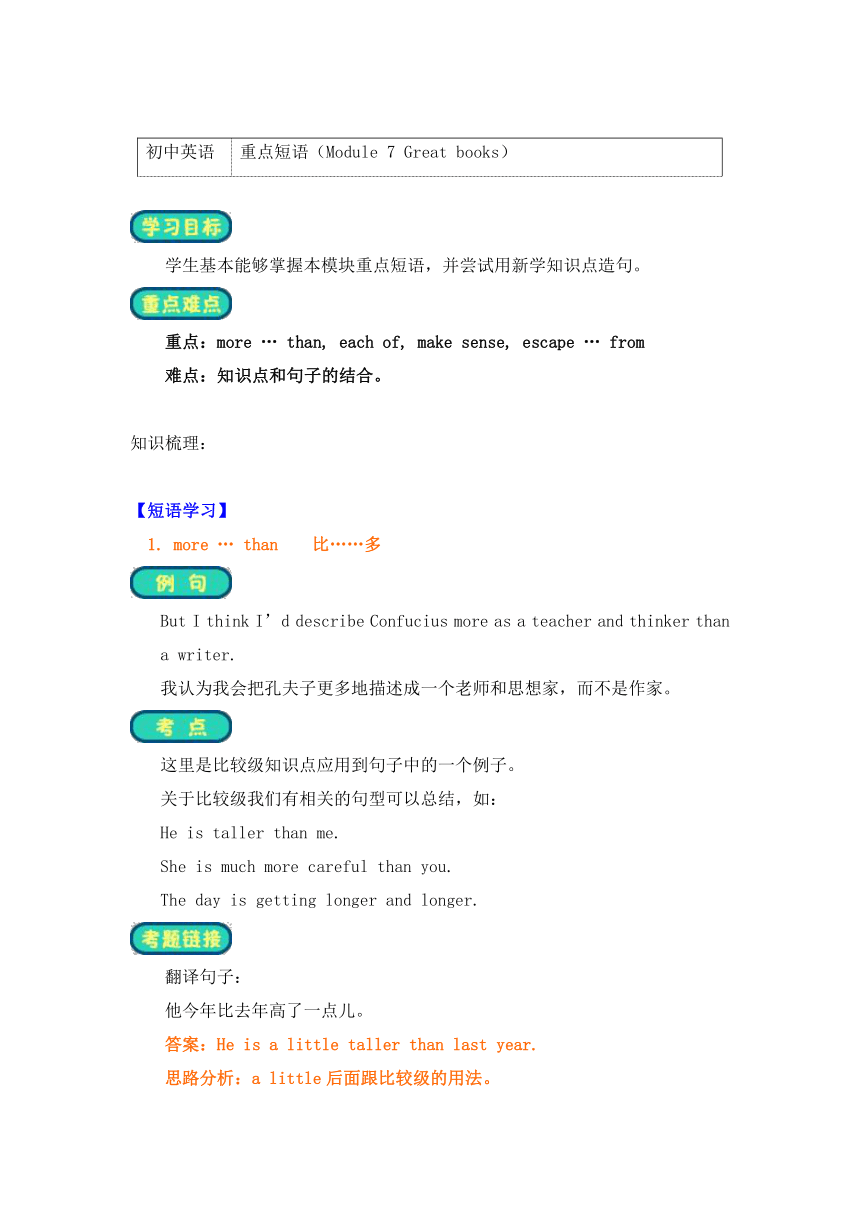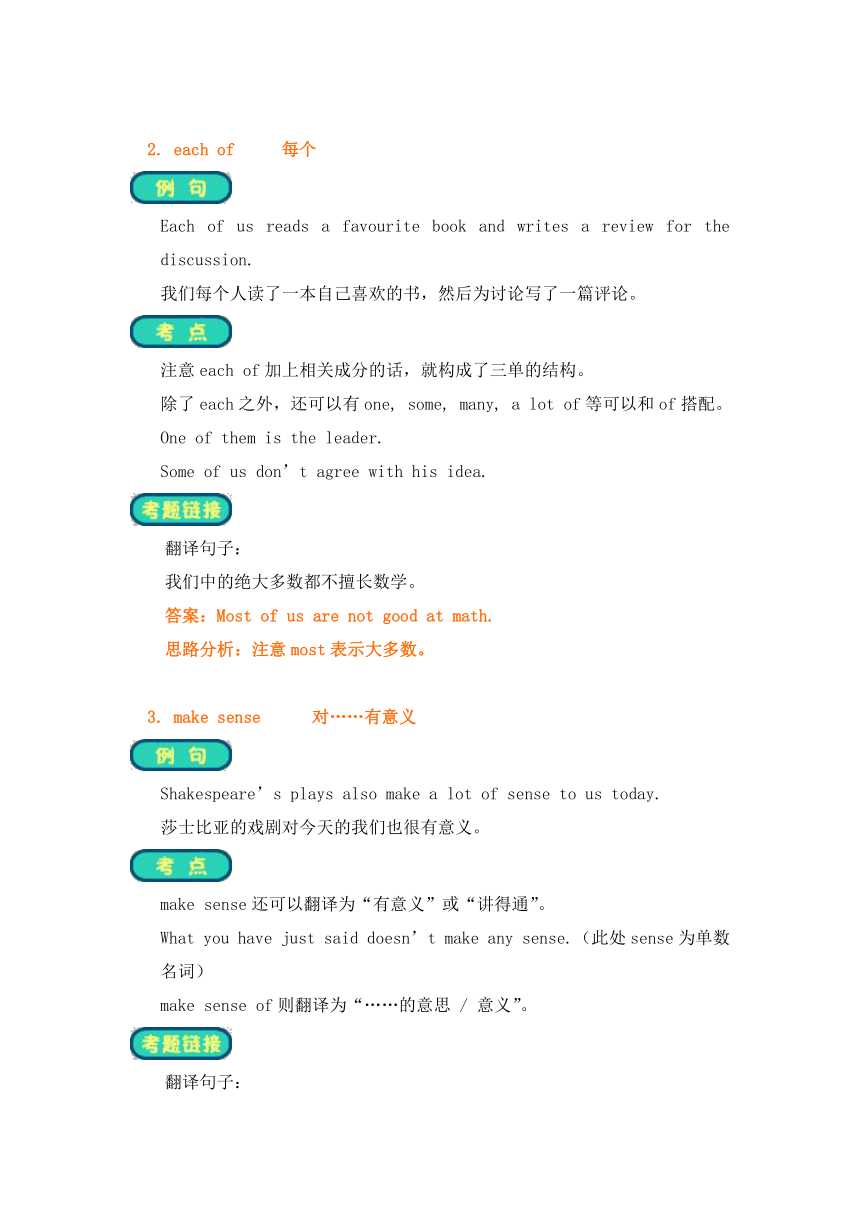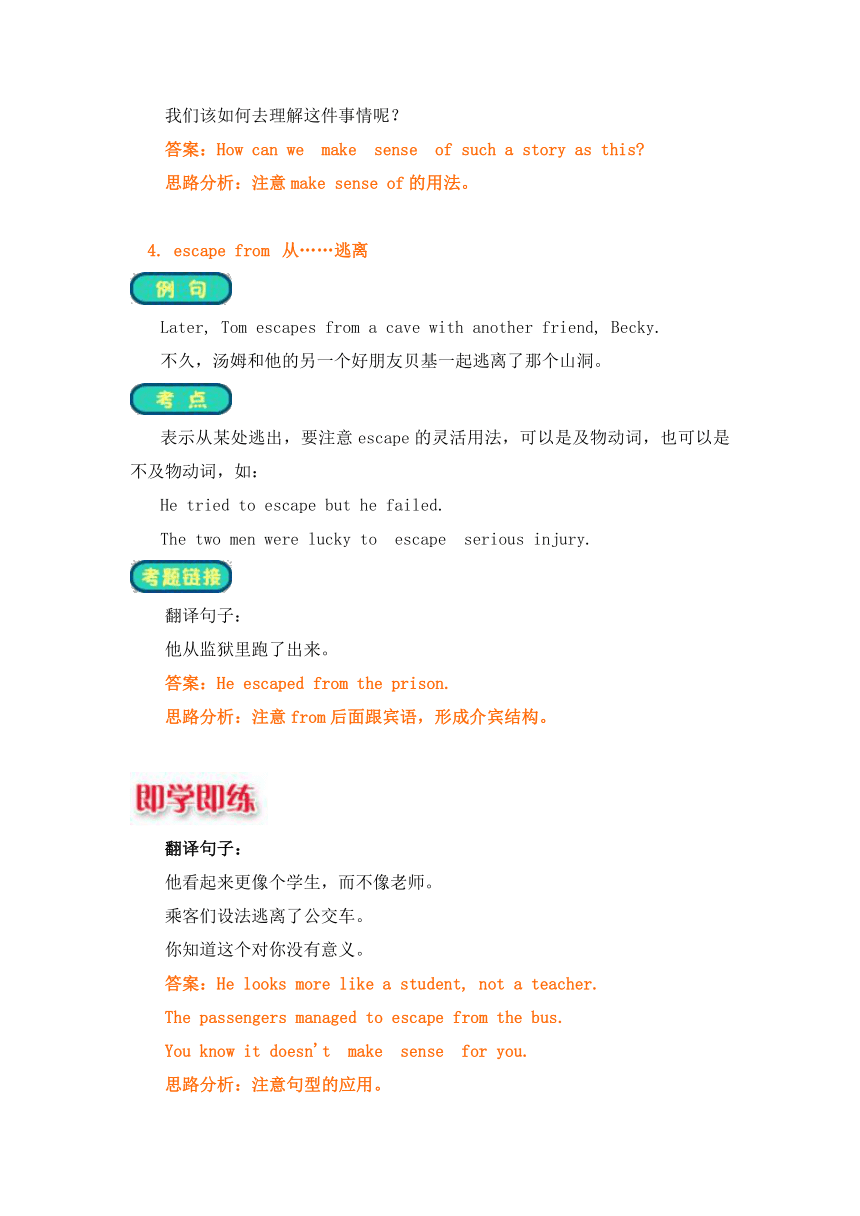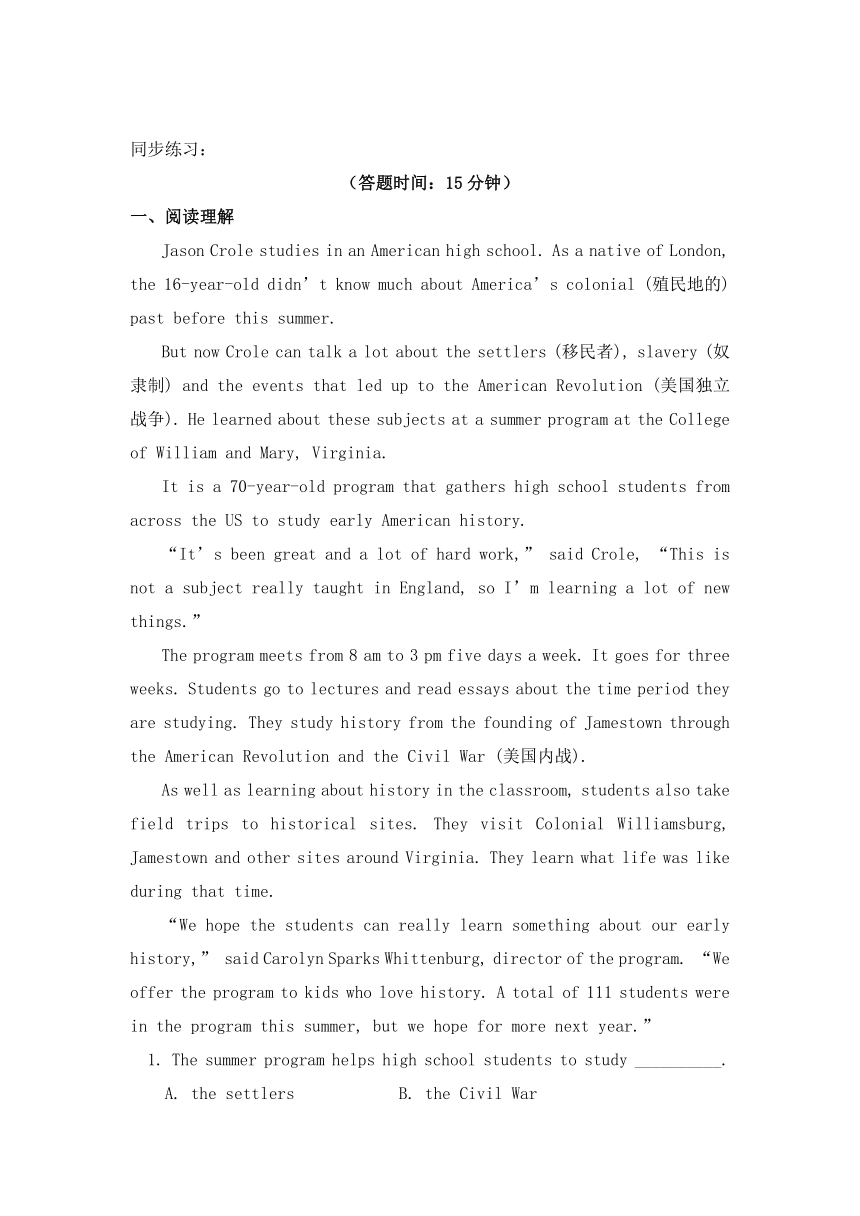九年级英语上册Module 7 Great books 导学案(含答案)
文档属性
| 名称 | 九年级英语上册Module 7 Great books 导学案(含答案) |  | |
| 格式 | doc | ||
| 文件大小 | 113.9KB | ||
| 资源类型 | 教案 | ||
| 版本资源 | 外研版 | ||
| 科目 | 英语 | ||
| 更新时间 | 2020-09-21 20:16:45 | ||
图片预览




文档简介
初中英语 重点短语(Module 7 Great books)
学生基本能够掌握本模块重点短语,并尝试用新学知识点造句。
重点:more … than, each of, make sense, escape … from
难点:知识点和句子的结合。
知识梳理:
【短语学习】
1. more … than 比……多
But I think I’d describe Confucius more as a teacher and thinker than a writer.
我认为我会把孔夫子更多地描述成一个老师和思想家,而不是作家。
这里是比较级知识点应用到句子中的一个例子。
关于比较级我们有相关的句型可以总结,如:
He is taller than me.
She is much more careful than you.
The day is getting longer and longer.
翻译句子:
他今年比去年高了一点儿。
答案:He is a little taller than last year.
思路分析:a little后面跟比较级的用法。
2. each of 每个
Each of us reads a favourite book and writes a review for the discussion.
我们每个人读了一本自己喜欢的书,然后为讨论写了一篇评论。
注意each of加上相关成分的话,就构成了三单的结构。
除了each之外,还可以有one, some, many, a lot of等可以和of搭配。
One of them is the leader.
Some of us don’t agree with his idea.
翻译句子:
我们中的绝大多数都不擅长数学。
答案:Most of us are not good at math.
思路分析:注意most表示大多数。
3. make sense 对……有意义
Shakespeare’s plays also make a lot of sense to us today.
莎士比亚的戏剧对今天的我们也很有意义。
make sense还可以翻译为“有意义”或“讲得通”。
What you have just said doesn’t make any sense.(此处sense为单数名词)
make sense of则翻译为“……的意思 / 意义”。
翻译句子:
我们该如何去理解这件事情呢?
答案:How can we?make?sense?of such a story as this?
思路分析:注意make sense of的用法。
4. escape from 从……逃离
Later, Tom escapes from a cave with another friend, Becky.
不久,汤姆和他的另一个好朋友贝基一起逃离了那个山洞。
表示从某处逃出,要注意escape的灵活用法,可以是及物动词,也可以是不及物动词,如:
He tried to escape but he failed.
The two men were lucky to?escape?serious injury.
翻译句子:
他从监狱里跑了出来。
答案:He escaped from the prison.
思路分析:注意from后面跟宾语,形成介宾结构。
翻译句子:
他看起来更像个学生,而不像老师。
乘客们设法逃离了公交车。
你知道这个对你没有意义。
答案:He looks more like a student, not a teacher.
The passengers managed to escape from the bus.
You know it doesn't?make?sense?for you.
思路分析:注意句型的应用。
同步练习:
(答题时间:15分钟)
一、阅读理解
Jason Crole studies in an American high school. As a native of London, the 16-year-old didn’t know much about America’s colonial (殖民地的) past before this summer.
But now Crole can talk a lot about the settlers (移民者), slavery (奴隶制) and the events that led up to the American Revolution (美国独立战争). He learned about these subjects at a summer program at the College of William and Mary, Virginia.
It is a 70-year-old program that gathers high school students from across the US to study early American history.
“It’s been great and a lot of hard work,” said Crole, “This is not a subject really taught in England, so I’m learning a lot of new things.”
The program meets from 8 am to 3 pm five days a week. It goes for three weeks. Students go to lectures and read essays about the time period they are studying. They study history from the founding of Jamestown through the American Revolution and the Civil War (美国内战).
As well as learning about history in the classroom, students also take field trips to historical sites. They visit Colonial Williamsburg, Jamestown and other sites around Virginia. They learn what life was like during that time.
“We hope the students can really learn something about our early history,” said Carolyn Sparks Whittenburg, director of the program. “We offer the program to kids who love history. A total of 111 students were in the program this summer, but we hope for more next year.”
1. The summer program helps high school students to study __________.
A. the settlers B. the Civil War
C. the American Revolution D. American History
2. The summer program lasts for ___________.
A. seven hours B. five days C. three weeks D. one month
3. Which of the following is true according to the passage?
A. There were hundreds of students in the program this summer.
B. Some students are not quite clear about American’s colonial past
C. Students can take part in the summer program in their high school
D. The subject is taught outside the classroom rather than inside
二、还原句子
A. The dog also has many other skills. B. He loves to work in different colors
C. I saw dolphins paint and elephants paint.
D. People have come from far away just to buy his work.
E. But he's also a painter
Sam is a dog who lives in Maryland, US. 4 . And some of his paintings have sold for $1,700.
Sam holds a special paintbrush in his mouth to paint. Mary Stadelbacher, Sam's owner, said Sam loves painting and can do it for hours. “ 5 He paints his paintings with darker colors first and then moves onto lighter ones,” she said.
Mary, the owner of a dog service center, took in 6-year-old Sam four years ago. She came up with the idea of teaching Sam to paint after seeing reports about animal painters. “ 6 So I thought, why not a dog?” Now the money from the dog's art sales helps to keep the dog service center open.
“Sam's paintings have been on show at New York galleries. 7 ,” Mary said.
“We even had one woman buy her dog one of Sam's paintings as a birthday present.”
三、任务型阅读
Who was Leonardo da Vinci? You may answer without thinking: “He is the painter of the Mona Lisa.” What else do you know about him? Da Vinci was more than just a great artist in history. He’s also famous as a scientist and an inventor.
Recently, the Grand Rapids Public Museum in the US had an exhibition to introduce this great talent. In one of the shows, named “Leonardo da Vinci’s Machines in Motion”, visitors could see and touch 30 full-size machines built according to his sketches– including a crane (起重机) and a robot!
Leonardo da Vinci was born to a rich family in Florence, Italy, in 1452. From childhood, Leonardo was given a good education and he showed talent at painting. By the age of 26, da Vinci had already become a famous painter.
However, he showed that he had multiple talents in 1482 when he began to work for the Duke of Milan as a chief engineer. In the duke’s military factories, da Vinci developed an interest in war weapons.
He designed many important machines, including helicopters and parachutes. He also drew and wrote about an armored car, which could carry eight men inside and allow them to fire weapons through holes in its walls. Da Vinci’s idea led to the modern tank. Though da Vinci never built many of the inventions he designed, some of the things he imagined in the late 1400s are in use today.
As a scientist, da Vinci was interested in the human body. He spent a whole year cutting up dead bodies in hospitals to learn about human anatomy (解剖). He made more than 200 drawings of bodies.
Amazingly, da Vinci wrote backward, so the easiest way to read his notes was to hold them up to a mirror!
8. Was the Mona Lisa painted by Leonardo da Vinci?
9. When was Leonardo da Vinci born?
10. What did Leonardo da Vinci design?
11. Why did Leonardo da Vinci cut up dead bodies in hospitals?
12. What was Leonardo da Vinci according to the passage?
答案:
一、阅读理解
1. D 解析:根据文章第三段可得答案为D。
2. C 解析:根据文章第五段第一行,选C。
3. B 解析:最后由一段可知A项错误;由第一段可知C项错误;由倒数第二段可知D项错误。根据文章最后一段综合分析,选B。
二、还原句子
4. E 5. B 6. C 7. D
三、任务型阅读
8. Yes.
9. In 1452.
10. Many important machines.
11. Because he wanted to learn about human anatomy.
12. Leonardo da Vinci was not only a great artist but also a famous scientist and an inventor.
学生基本能够掌握本模块重点短语,并尝试用新学知识点造句。
重点:more … than, each of, make sense, escape … from
难点:知识点和句子的结合。
知识梳理:
【短语学习】
1. more … than 比……多
But I think I’d describe Confucius more as a teacher and thinker than a writer.
我认为我会把孔夫子更多地描述成一个老师和思想家,而不是作家。
这里是比较级知识点应用到句子中的一个例子。
关于比较级我们有相关的句型可以总结,如:
He is taller than me.
She is much more careful than you.
The day is getting longer and longer.
翻译句子:
他今年比去年高了一点儿。
答案:He is a little taller than last year.
思路分析:a little后面跟比较级的用法。
2. each of 每个
Each of us reads a favourite book and writes a review for the discussion.
我们每个人读了一本自己喜欢的书,然后为讨论写了一篇评论。
注意each of加上相关成分的话,就构成了三单的结构。
除了each之外,还可以有one, some, many, a lot of等可以和of搭配。
One of them is the leader.
Some of us don’t agree with his idea.
翻译句子:
我们中的绝大多数都不擅长数学。
答案:Most of us are not good at math.
思路分析:注意most表示大多数。
3. make sense 对……有意义
Shakespeare’s plays also make a lot of sense to us today.
莎士比亚的戏剧对今天的我们也很有意义。
make sense还可以翻译为“有意义”或“讲得通”。
What you have just said doesn’t make any sense.(此处sense为单数名词)
make sense of则翻译为“……的意思 / 意义”。
翻译句子:
我们该如何去理解这件事情呢?
答案:How can we?make?sense?of such a story as this?
思路分析:注意make sense of的用法。
4. escape from 从……逃离
Later, Tom escapes from a cave with another friend, Becky.
不久,汤姆和他的另一个好朋友贝基一起逃离了那个山洞。
表示从某处逃出,要注意escape的灵活用法,可以是及物动词,也可以是不及物动词,如:
He tried to escape but he failed.
The two men were lucky to?escape?serious injury.
翻译句子:
他从监狱里跑了出来。
答案:He escaped from the prison.
思路分析:注意from后面跟宾语,形成介宾结构。
翻译句子:
他看起来更像个学生,而不像老师。
乘客们设法逃离了公交车。
你知道这个对你没有意义。
答案:He looks more like a student, not a teacher.
The passengers managed to escape from the bus.
You know it doesn't?make?sense?for you.
思路分析:注意句型的应用。
同步练习:
(答题时间:15分钟)
一、阅读理解
Jason Crole studies in an American high school. As a native of London, the 16-year-old didn’t know much about America’s colonial (殖民地的) past before this summer.
But now Crole can talk a lot about the settlers (移民者), slavery (奴隶制) and the events that led up to the American Revolution (美国独立战争). He learned about these subjects at a summer program at the College of William and Mary, Virginia.
It is a 70-year-old program that gathers high school students from across the US to study early American history.
“It’s been great and a lot of hard work,” said Crole, “This is not a subject really taught in England, so I’m learning a lot of new things.”
The program meets from 8 am to 3 pm five days a week. It goes for three weeks. Students go to lectures and read essays about the time period they are studying. They study history from the founding of Jamestown through the American Revolution and the Civil War (美国内战).
As well as learning about history in the classroom, students also take field trips to historical sites. They visit Colonial Williamsburg, Jamestown and other sites around Virginia. They learn what life was like during that time.
“We hope the students can really learn something about our early history,” said Carolyn Sparks Whittenburg, director of the program. “We offer the program to kids who love history. A total of 111 students were in the program this summer, but we hope for more next year.”
1. The summer program helps high school students to study __________.
A. the settlers B. the Civil War
C. the American Revolution D. American History
2. The summer program lasts for ___________.
A. seven hours B. five days C. three weeks D. one month
3. Which of the following is true according to the passage?
A. There were hundreds of students in the program this summer.
B. Some students are not quite clear about American’s colonial past
C. Students can take part in the summer program in their high school
D. The subject is taught outside the classroom rather than inside
二、还原句子
A. The dog also has many other skills. B. He loves to work in different colors
C. I saw dolphins paint and elephants paint.
D. People have come from far away just to buy his work.
E. But he's also a painter
Sam is a dog who lives in Maryland, US. 4 . And some of his paintings have sold for $1,700.
Sam holds a special paintbrush in his mouth to paint. Mary Stadelbacher, Sam's owner, said Sam loves painting and can do it for hours. “ 5 He paints his paintings with darker colors first and then moves onto lighter ones,” she said.
Mary, the owner of a dog service center, took in 6-year-old Sam four years ago. She came up with the idea of teaching Sam to paint after seeing reports about animal painters. “ 6 So I thought, why not a dog?” Now the money from the dog's art sales helps to keep the dog service center open.
“Sam's paintings have been on show at New York galleries. 7 ,” Mary said.
“We even had one woman buy her dog one of Sam's paintings as a birthday present.”
三、任务型阅读
Who was Leonardo da Vinci? You may answer without thinking: “He is the painter of the Mona Lisa.” What else do you know about him? Da Vinci was more than just a great artist in history. He’s also famous as a scientist and an inventor.
Recently, the Grand Rapids Public Museum in the US had an exhibition to introduce this great talent. In one of the shows, named “Leonardo da Vinci’s Machines in Motion”, visitors could see and touch 30 full-size machines built according to his sketches– including a crane (起重机) and a robot!
Leonardo da Vinci was born to a rich family in Florence, Italy, in 1452. From childhood, Leonardo was given a good education and he showed talent at painting. By the age of 26, da Vinci had already become a famous painter.
However, he showed that he had multiple talents in 1482 when he began to work for the Duke of Milan as a chief engineer. In the duke’s military factories, da Vinci developed an interest in war weapons.
He designed many important machines, including helicopters and parachutes. He also drew and wrote about an armored car, which could carry eight men inside and allow them to fire weapons through holes in its walls. Da Vinci’s idea led to the modern tank. Though da Vinci never built many of the inventions he designed, some of the things he imagined in the late 1400s are in use today.
As a scientist, da Vinci was interested in the human body. He spent a whole year cutting up dead bodies in hospitals to learn about human anatomy (解剖). He made more than 200 drawings of bodies.
Amazingly, da Vinci wrote backward, so the easiest way to read his notes was to hold them up to a mirror!
8. Was the Mona Lisa painted by Leonardo da Vinci?
9. When was Leonardo da Vinci born?
10. What did Leonardo da Vinci design?
11. Why did Leonardo da Vinci cut up dead bodies in hospitals?
12. What was Leonardo da Vinci according to the passage?
答案:
一、阅读理解
1. D 解析:根据文章第三段可得答案为D。
2. C 解析:根据文章第五段第一行,选C。
3. B 解析:最后由一段可知A项错误;由第一段可知C项错误;由倒数第二段可知D项错误。根据文章最后一段综合分析,选B。
二、还原句子
4. E 5. B 6. C 7. D
三、任务型阅读
8. Yes.
9. In 1452.
10. Many important machines.
11. Because he wanted to learn about human anatomy.
12. Leonardo da Vinci was not only a great artist but also a famous scientist and an inventor.
同课章节目录
- Module 1 Wonders of the world
- Unit 1 It's more than 2,000 years old.
- Unit 2 The Grand Canyon was not just big.
- Unit 3 Language in use
- Module 2 Public holidays
- Unit 1 My family always go somewhere interesting a
- Unit 2 We have celebrated the festival since the f
- Unit 3 Language in use
- Module 3 Heroes
- Unit 1 She trained hard,so she became a great play
- Unit 2There were few doctors, so he had to work ve
- Unit 3 Language in use
- Module 4 Home alone
- Unit 1 I can look after myself, although it won’t
- Unit 2 I became so bored with their orders that I
- Unit 3 Language in use
- Module 5 Museums
- Unit 1 Don't cross that rope!
- Unit 2 If you ever go to London, make sure you vis
- Unit 3 Language in use
- Module 6 Problems
- Unit 1 If I start after dinner, I'll finish it be
- Unit 2 If you tell him the truth now, you will sho
- Unit 3 Language in use
- Revision Module A
- Module 7 Great books
- Unit 1 We're still influenced by Confucius's idea
- Unit 2 It is still read and loved.
- Unit 3 Language in use
- Module 8 Sports life
- Unit 1 Daming wasn't chosen for the team last time
- Unit 2 He was invited to competitions around the w
- Unit 3 Language in use
- Module 9 Great inventions
- Unit 1 Will computers be used more than books in t
- Unit 2 Will books be replaced by the Internet?
- Unit 3 Language in use
- Module 10 Australia
- Unit 1 I have some photos that I took in Australia
- Unit 2 The game that they like most is Australian
- Unit 3 Language in use
- Module 11 Photos
- Unit 1 He's the boy who won the photo competition
- Unit 2 The photo which we liked best was taken by
- Unit 3 Language in use
- Module 12 Save our world
- Unit 1 If everyone starts to do something, the wor
- Unit 2 Repeat these three words daily: reduce, reu
- Unit 3 Language in use
- Revision Module B
